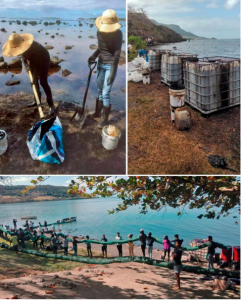The MV Wakashio accident: What happened?

Does Mauritius ring a bell? You may have heard of this tiny Indian Ocean island last year, when its pristine lagoons were hit by the worst oil spill it had ever known, making news all around the world. On July 25, 2020, the MV Wakashio, a 300 m long Japanese tanker ran aground on a barrier reef off the south-east coast of Mauritius, and two weeks later, it began leaking this fuel into the sea. According to official statements, it carried around 4 million liters of fuel (an Olympic-sized swimming pool has a volume of 2.5 million liters – about half that). The disaster prompted a state of environmental emergency and a cry for international aid to help the small country contain the spill.
How was the oil spill contained?

Without thinking twice, the local population, with the help of non-governmental organizations (NGOs) and community service groups, aided in oil removal operations from the sea surface and along the coastline. In this massive citizen effort, about 2 million liters of contaminated liquid waste (oil mixed with seawater) was effectively cleaned from the coastline. While clean-up operations are still ongoing, such an ecological disaster has affected highly sensitive sites around the island, including marine protected areas, nature reserves, and mangrove forests, and it has severely impacted the local communities that rely on them. Part of the affected shoreline has been restricted to fishing and recreational activities, and although no trace of oil is visible on the sea surface after the clean-up efforts, there are still large accumulations in the mangrove forests, which may have long-term consequences.
How did the oil spill affect the island’s mangroves?

Mangroves have been particularly impacted by the oil spill in Mauritius, which raises concerns because this sensitive ecosystem is an important nursery ground for various marine species such as fish and shellfish. When the oil is released into the coastal waters and reaches the shore, it deposits on the sediments that cover the roots of mangrove trees and sticks on the plant surface. Not only does the oil stick to the breathing surfaces of the mangrove trees and their surrounding sediments, but it also suffocates the tiny organisms that live in burrows and root hollows. Shorter plants and animals die mostly within days, while taller trees, where oil only deposited on their roots and sediments may survive for 6 or more months before eventually dying. To help monitor and restore the affected mangrove communities, a working group was set up, comprised of local officers, researchers, and scientists, as well as foreign scientists from Japan and the United Nations. The aim was to assemble a team with diverse expertise and local field experience to coordinate the monitoring and restoration efforts, including potential mangrove farming, but to date, discussions are still ongoing.
How did the oil spill affect other marine communities?

In addition to mangroves, oil spills can have impacts on other marine organisms, which range in size from small microorganisms to large mammals. Corals can be particularly vulnerable, because their reproduction can be severely impaired. However, the annual mass coral spawning, which is the period where the corals release their eggs to be fertilized for reproduction, has been observed in the impacted area at the beginning of November 2020 like previous years. This means that the oil spill has fortunately not altered the timing of the release of eggs, for 2020 at least. On the other end, almost 20 days after the oil spill, 51 dolphins were washed ashore in the same region where the oil spill occurred. Although visual analysis of their skin, digestive and respiratory tract revealed no trace of oil, which initially dismissed the oil spill as the cause of their death, further analysis of samples in the laboratory found the presence of oil in 11 of the dead dolphins.
What does this mean for the economy and ecology of Mauritius?

Being a well-known touristic spot for leisure, sight-seeing, scuba-diving and water sports, Mauritius has one of the most famous coral reefs in the world, comprising a rich marine biodiversity. However, the island lies in an area with heavy shipping traffic, which can be a hazard for its biodiversity and natural treasures. The MV Wakashio accident is living proof of this. The effects could have been worst, but thanks to the mighty Mauritian citizens, who put their hearts and souls into helping contain the ecological disaster, and worldwide efforts, the oil spill was contained, and the damage minimized. However, the assessment of the impacts on marine life and the actions to restore the affected ecosystems are still in progress after several months, and will probably last for years.
If you are interested in learning more about the ongoing cleanup efforts, you are welcome to follow the Mauritian non-governmental organization EcoSud, and watch this youtube video.
Born and raised on Mauritius Island in the Indian Ocean, I came to the United States in 2015 as a Fulbright scholar to pursue a Masters degree in Marine Science at North Carolina State University. After completing my Masters degree, I stayed at NC State University where I complete my Ph.D., working in parallel as an ORISE fellow at the U.S. EPA. My research focused on two blue carbon habitats: seagrass meadows and salt marshes. I applied different methods including satellite remote sensing and machine learning to fill the current knowledge gaps in the areal extent and carbon storage capacity of these important blue carbon sinks for better monitoring and management of such ecosystems in the face of climate and anthropogenic pressures. I am now an Associate with Silvestrum Climate Associates, developing blue carbon restoration and conservation projects. When not sciencing, I enjoy my daily yoga routines, taking care of my house plants, watching f.r.i.e.n.d.s for the hundredth time, and nature walks/hikes.


